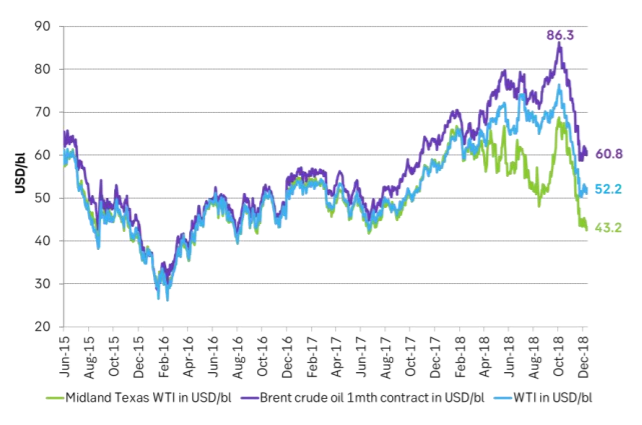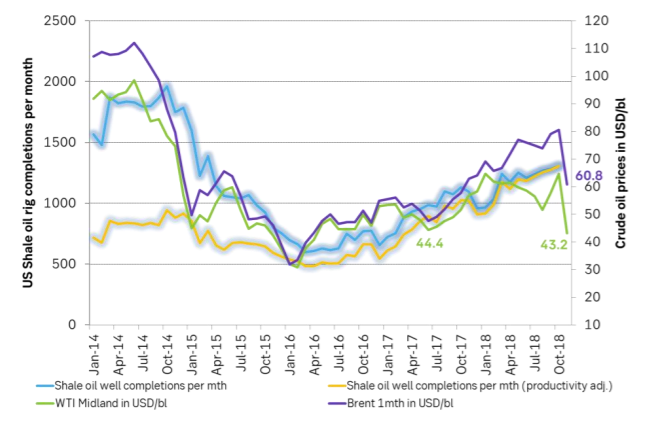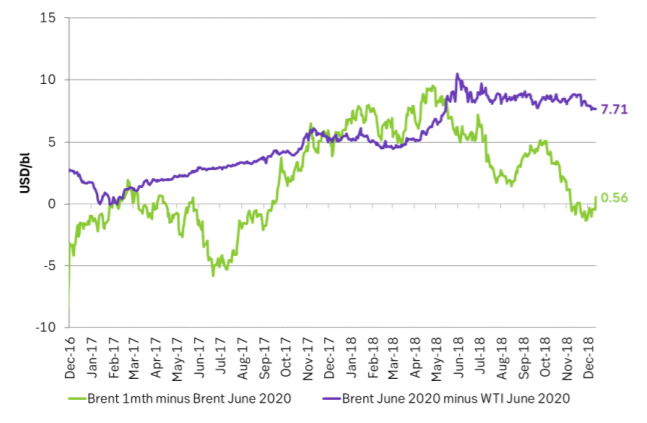Analys
OPEC+ tightens the front. Producers lean on the back

 We are quite confident that OPEC+ will be successful in tightening up the front end of the oil market thus keeping the Brent crude oil 1mth contract in $60+/bl territory over the next 6 mths.
We are quite confident that OPEC+ will be successful in tightening up the front end of the oil market thus keeping the Brent crude oil 1mth contract in $60+/bl territory over the next 6 mths.
Investors and producers however fear a tsunami of additional US shale oil supply in late 2019 and 2020 as new pipelines are installed from the Permian to the US Gulf.
As a consequence Brent crude oil prices are likely to be supported at the front by OPEC+ while investors and producers will be active sellers of oil for late 2019 and 2020. This will likely push the Brent crude curve into proper backwardation again with the front a little higher but with bearish pressure on the medium term contracts. Backwardation will attract more speculators, again adding upwards push in the front.
US shale production continues to grow in the Permian basin, but pipeline capacity is full and new pipelines will not be there until late 2019. As such we expect the local Permian crude price to sink yet lower in order to tame production growth and match it to current installed pipeline capacity. Local Permian crude is already down at $43/bl.
As a consequence the Brent crude to WTI Cushing and to local Permian crude price spreads should continue to widen for a while yet. These spreads could however be pushed tighter for late 2019 and 2020 durations. This will add to the picture above: Support for front end Brent but weakness for medium term 2020/2021 Brent prices.
Conclusion:
- Stay long front month Brent versus short June 2020 Brent crude.
- Stay short the Brent versus long WTI for June 2020
It is important to remember that the sharp decline in oil prices during October and November to a very large degree was driven by a strong increase in production by OPEC/OPEC+. Partially as a tactically lead-up to the recent OPEC+ meeting. As such we believe they are fully capable of tightening up the front end of the oil market again as well. Saudi Arabia produced 11.1 m bl/d in November and delivered an additional 0.2 m bl/d from inventory. In January they’ll produce 10.2 m bl/d. That’s a strong physical tightening. Yes production was (and still is) also growing strongly in the US, but that was really not a surprise at all. The following is the likely mix sinking the oil price dramatically since early October:
- Softer global growth outlook (and thus softer oil demand growth outlook for 2019)
- A sharp sell-off in the S&P 500 index
- A strong rise in production by OPEC+
- Unexpected US Iran-waivers which enabled continued significant volumes of exports from Iran.
- A huge exodus of net long speculative positions in Brent crude and WTI crude
Of course booming US shale oil production was an important factor, but it was not a surprise this autumn. Strong US shale oil production growth has not been a problem over the past two years because: 1) Global oil demand has been strong adding 3 m bl/d in two years and 2) Losses in other supply of more than 2 m bl/d in two years has made additional room for growing US production. Strongly growing US shale oil production became a problem this autumn because demand growth was expected to slow with slower global economic growth while further steep losses from Iran were avoided due to allowance for waivers.
Brent is jumping 1.9% today to $61.4/bl as API expects US crude stocks to show a 10.2 m bl/d draw in today’s numbers at 16:30 CET. Lost supply in Libya this week also adds to the bullish sentiment.
Ch1: Market has moved from a situation where the oil price needed to slow down global demand to balance the market with global benchmark Brent crude at $86.3/bl in early October to instead a market state where the oil price needs to do the job of slowing down US shale oil production growth. I.e. the local US crude benchmarks have moved to low $40-50/bl.
Ch2: US shale oil well completions per month is what matters for US shale oil supply growth. The local Permian crude oil price is now working hard to slow down well completions per month in order to balance local Permian supply to pipeline capacity
Ch3: OPEC+ will tighten up the front Brent market while producers will sell 2020 Brent contracts fearing a wave of additional US shale oil supply in 2020 as new pipelines from Permian to US Gulf comes online. June 2020 Brent – JuneWTI 2020 likely erode going forward in expectation that oil flows to the US Gulf will be uncloged with new pipelines. Green graph to move higher. Lilac to move lower
Analys
OPEC+ in a process of retaking market share

Oil prices are likely to fall for a fourth straight year as OPEC+ unwinds cuts and retakes market share. We expect Brent crude to average USD 55/b in Q4/25 before OPEC+ steps in to stabilise the market into 2026. Surplus, stock building, oil prices are under pressure with OPEC+ calling the shots as to how rough it wants to play it. We see natural gas prices following parity with oil (except for seasonality) until LNG surplus arrives in late 2026/early 2027.

Oil market: Q4/25 and 2026 will be all about how OPEC+ chooses to play it
OPEC+ is in a process of unwinding voluntary cuts by a sub-group of the members and taking back market share. But the process looks set to be different from 2014-16, as the group doesn’t look likely to blindly lift production to take back market share. The group has stated very explicitly that it can just as well cut production as increase it ahead. While the oil price is unlikely to drop as violently and lasting as in 2014-16, it will likely fall further before the group steps in with fresh cuts to stabilise the price. We expect Brent to fall to USD 55/b in Q4/25 before the group steps in with fresh cuts at the end of the year.

Natural gas market: Winter risk ahead, yet LNG balance to loosen from 2026
The global gas market entered 2025 in a fragile state of balance. European reliance on LNG remains high, with Russian pipeline flows limited to Turkey and Russian LNG constrained by sanctions. Planned NCS maintenance in late summer could trim exports by up to 1.3 TWh/day, pressuring EU storage ahead of winter. Meanwhile, NE Asia accounts for more than 50% of global LNG demand, with China alone nearing a 20% share (~80 mt in 2024). US shale gas production has likely peaked after reaching 104.8 bcf/d, even as LNG export capacity expands rapidly, tightening the US balance. Global supply additions are limited until late 2026, when major US, Qatari and Canadian projects are due to start up. Until then, we expect TTF to average EUR 38/MWh through 2025, before easing as the new supply wave likely arrives in late 2026 and then in 2027.
Analys
Manufacturing PMIs ticking higher lends support to both copper and oil

Price action contained withing USD 2/b last week. Likely muted today as well with US closed. The Brent November contract is the new front-month contract as of today. It traded in a range of USD 66.37-68.49/b and closed the week up a mere 0.4% at USD 67.48/b. US oil inventory data didn’t make much of an impact on the Brent price last week as it is totally normal for US crude stocks to decline 2.4 mb/d this time of year as data showed. This morning Brent is up a meager 0.5% to USD 67.8/b. It is US Labor day today with US markets closed. Today’s price action is likely going to be muted due to that.

Improving manufacturing readings. China’s manufacturing PMI for August came in at 49.4 versus 49.3 for July. A marginal improvement. The total PMI index ticked up to 50.5 from 50.2 with non-manufacturing also helping it higher. The HCOB Eurozone manufacturing PMI was a disastrous 45.1 last December, but has since then been on a one-way street upwards to its current 50.5 for August. The S&P US manufacturing index jumped to 53.3 in August which was the highest since 2022 (US ISM manufacturing tomorrow). India manufacturing PMI rose further and to 59.3 for August which is the highest since at least 2022.
Are we in for global manufacturing expansion? Would help to explain copper at 10k and resilient oil. JPMorgan global manufacturing index for August is due tomorrow. It was 49.7 in July and has been below the 50-line since February. Looking at the above it looks like a good chance for moving into positive territory for global manufacturing. A copper price of USD 9935/ton, sniffing at the 10k line could be a reflection of that. An oil price holding up fairly well at close to USD 68/b despite the fact that oil balances for Q4-25 and 2026 looks bloated could be another reflection that global manufacturing may be accelerating.
US manufacturing PMI by S&P rose to 53.3 in August. It was published on 21 August, so not at all newly released. But the US ISM manufacturing PMI is due tomorrow and has the potential to follow suite with a strong manufacturing reading.
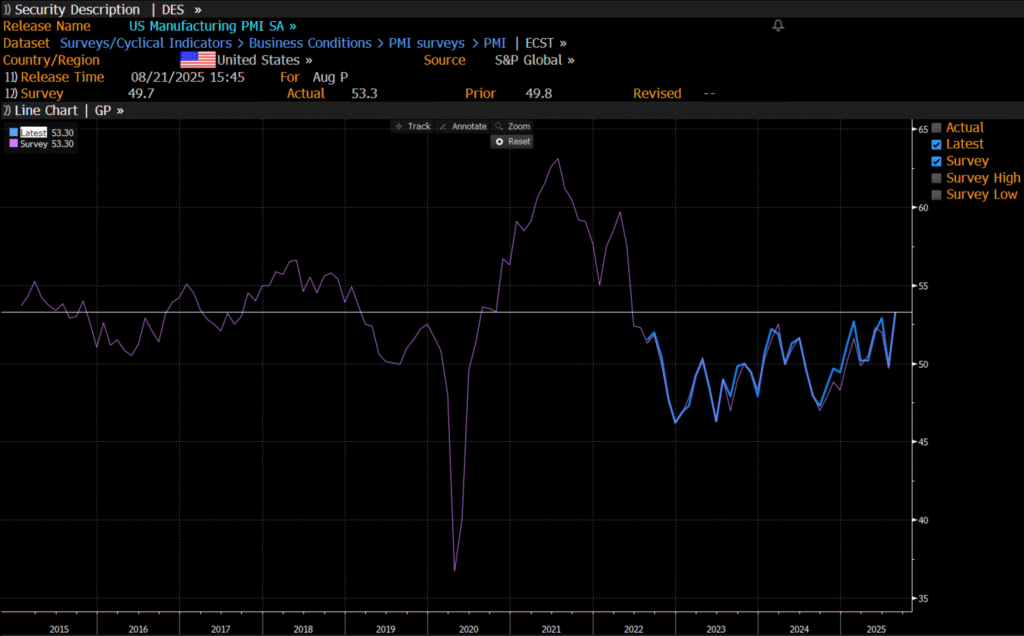
Analys
Crude stocks fall again – diesel tightness persists

U.S. commercial crude inventories posted another draw last week, falling by 2.4 million barrels to 418.3 million barrels, according to the latest DOE report. Inventories are now 6% below the five-year seasonal average, underlining a persistently tight supply picture as we move into the post-peak demand season.

While the draw was smaller than last week’s 6 million barrel decline, the trend remains consistent with seasonal patterns. Current inventories are still well below the 2015–2022 average of around 449 million barrels.
Gasoline inventories dropped by 1.2 million barrels and are now close to the five-year average. The breakdown showed a modest increase in finished gasoline offset by a decline in blending components – hinting at steady end-user demand.
Diesel inventories saw yet another sharp move, falling by 1.8 million barrels. Stocks are now 15% below the five-year average, pointing to sustained tightness in middle distillates. In fact, diesel remains the most undersupplied segment, with current inventory levels at the very low end of the historical range (see page 3 attached).
Total commercial petroleum inventories – including crude and products but excluding the SPR – fell by 4.4 million barrels on the week, bringing total inventories to approximately 1,259 million barrels. Despite rising refinery utilization at 94.6%, the broader inventory complex remains structurally tight.
On the demand side, the DOE’s ‘products supplied’ metric – a proxy for implied consumption – stayed strong. Total product demand averaged 21.2 million barrels per day over the last four weeks, up 2.5% YoY. Diesel and jet fuel were the standouts, up 7.7% and 1.7%, respectively, while gasoline demand softened slightly, down 1.1% YoY. The figures reflect a still-solid late-summer demand environment, particularly in industrial and freight-related sectors.


-

 Nyheter3 veckor sedan
Nyheter3 veckor sedanOmgående mångmiljardfiasko för Equinors satsning på Ørsted och vindkraft
-
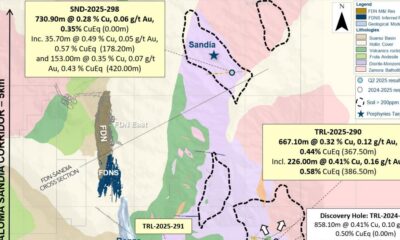
 Nyheter4 veckor sedan
Nyheter4 veckor sedanLundin Gold hittar ny koppar-guld-fyndighet vid Fruta del Norte-gruvan
-

 Nyheter2 veckor sedan
Nyheter2 veckor sedanMeta bygger ett AI-datacenter på 5 GW och 2,25 GW gaskraftverk
-

 Nyheter4 veckor sedan
Nyheter4 veckor sedanGuld stiger till över 3500 USD på osäkerhet i världen
-

 Analys3 veckor sedan
Analys3 veckor sedanWhat OPEC+ is doing, what it is saying and what we are hearing
-

 Nyheter2 veckor sedan
Nyheter2 veckor sedanAker BP gör ett av Norges största oljefynd på ett decennium, stärker resurserna i Yggdrasilområdet
-

 Nyheter4 veckor sedan
Nyheter4 veckor sedanAlkane Resources och Mandalay Resources har gått samman, aktör inom guld och antimon
-

 Nyheter4 veckor sedan
Nyheter4 veckor sedanLyten, tillverkare av litium-svavelbatterier, tar över Northvolts tillgångar i Sverige och Tyskland



